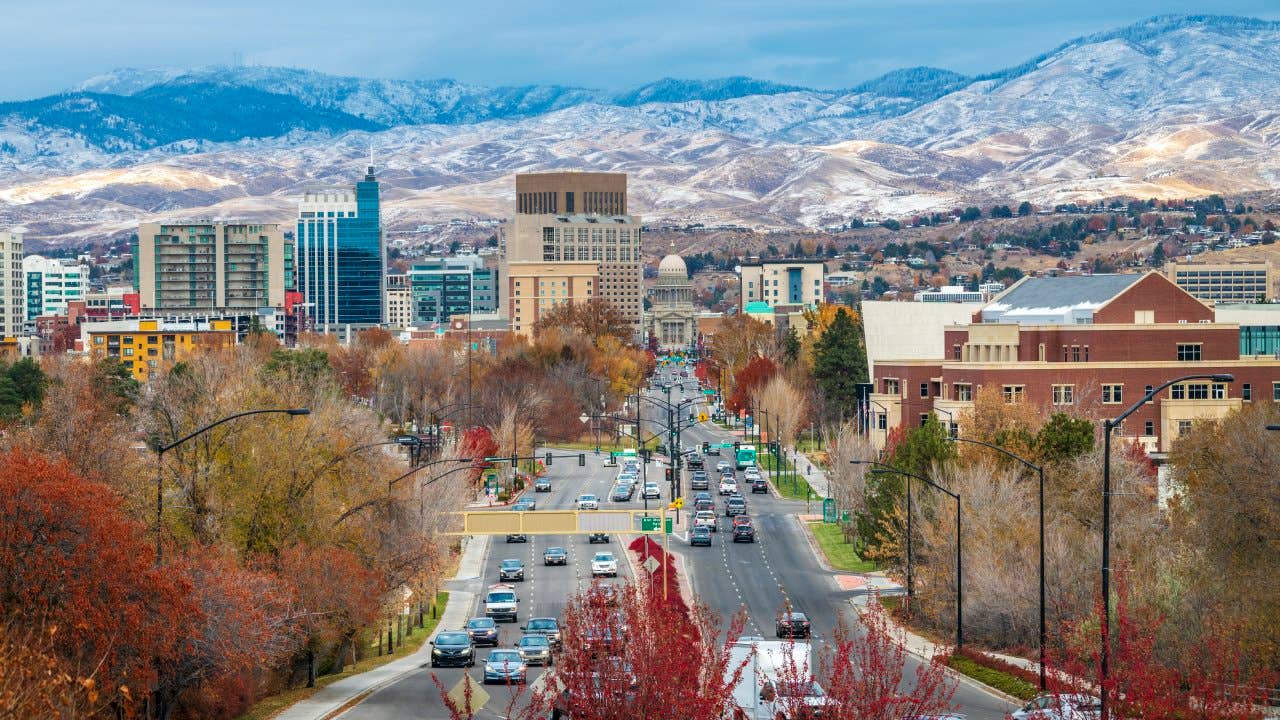Buying a house in Idaho: A how-to

The Bankrate promise
At Bankrate we strive to help you make smarter financial decisions. While we adhere to strict , this post may contain references to products from our partners. Here's an explanation for .
Idaho might be known for growing potatoes, but the state is also growing in a big way when it comes to people. Recent Census data shows that Idaho is actually the fastest-growing state in the country, with nearly 500,000 new residents moving there between 2011 and 2021. Throughout the pandemic, as residents in high-priced areas of the country like California looked at their bank accounts, the Gem State looked like a crown jewel — without the luxury price tag.
If you’re hoping to buy a house in Idaho, that big influx of newcomers means you should prepare for dealing with plenty of competition. Plus, the recent rise in mortgage rates might have you wondering whether you should buy now or wait. But It’s not all bad news for prospective Idaho homebuyers, though. Data from Windermere Real Estate Group shows that median prices have decreased in Boise, Valley and Blaine Counties between the third quarter of 2021 and 2022, as the housing market started to cool.
Read on to get a sense of what the market will look like in 2023 and how you can make this the year you become a homeowner in Idaho.
How to buy a house in Idaho
Decide where to live
Idaho stretches across more than 83,000 square miles, and the state offers something for every kind of lifestyle: a booming city vibe in the capital of Boise, the high-end feel of Teton County and an escape-from-everything rustic charm in small towns like Wallace and Couer d’Alene. No matter where you’re looking, though, the cost of living in Idaho is lower than the national average.
Make sure to think about the long-term outlook for you and your family when picking an area in Idaho to live. Ideally, you will be able to live in the home for at least five years to justify all your one-time transaction costs and moving fees. Think ahead to 2028: Will your expectations for schools, healthcare or other needs look different than they do today?
Tips for buying a house in Idaho
A couple tips about Gem State mortgages: Before you start house hunting, look at your bank account to see how much you can realistically contribute to the purchase. If you’re going to need to borrow a sum of cash that exceeds the conforming loan limit for 2023 — $726,200 in most counties, with higher limits in Camas, Blaine and Teton Counties — you will need to compare jumbo loan options. And if your credit is less-than-stellar and you’re planning to explore FHA loan options, you’ll likely have a much lower borrowing ceiling. In most areas of Idaho, 2023 FHA loans will be capped at $472,030.
Things to know about buying a house in Idaho
- Property taxes: In Idaho, property taxes are fairly affordable. Data from the Tax Foundation shows that the typical property-tax bill is 0.70 percent of a home’s value.
- Seller’s disclosure: Idaho law requires every seller to complete a fairly simple property disclosure form that includes knowledge of any defects or issues with the home.
- Closing costs: Closing costs are relatively affordable here, partly due to the fact that there are no real estate transfer taxes in Idaho. According to data from ClosingCorp, the typical Idaho home sale comes with closing costs that add up to 1 percent of the purchase price. Note, though, that your costs will be higher if you choose a lender that charges an origination fee, application fee or other loan costs.
- Dual agency: Dual agency is when the same agent or brokerage represents both parties in a single real estate transaction. The practice is permissible in Idaho (and many other states). However, because there can be an inherent conflict of interest, you’ll have to sign a consent form.
- Attorneys: You aren’t legally required to hire a real estate attorney when you’re buying a house in Idaho. However, you should strongly consider doing so anyway. Buying a home may be the most expensive transaction you ever complete, and it’s smart to have a legal expert review the contract and finalize the details.
- Climate and weather considerations: Since Idaho is a landlocked state, you might not think to consider flooding concerns. However, with more than 2,000 lakes and more than 93,000 miles of streams and rivers, 24 percent of properties in Idaho have a heightened level of flood risk. In addition, 36 percent of the state’s population lives in an area with elevated wildfire risk. And obviously, as the home of many popular ski destinations, Idaho gets plenty of snow as well. Be sure to think about how to protect your property from the natural damages that can occur with additional homeowners insurance coverage.
How much house can I afford in Idaho?
The first step is looking at your income. Most financial experts advise limiting your monthly mortgage payment to 28 percent of your income. That means that if you earn $8,000 each month, your housing bill should be $2,240 or less.
Any lender reviewing your mortgage application is going to look at a lot more than just your pay stubs, though. Your debt-to-income ratio plays a big role in home affordability. Think about your credit card balances, student loan payments and car payments as well. Most banks will limit your DTI to no more than 43 percent, including your housing payment, although some will accept up to 50 percent. Use Bankrate’s new-home calculator to get a sense of what you can afford.
Saving for a down payment in Idaho
The average down payment on a new home in Idaho was $94,000 in the spring of 2022. However, you can get by with a much smaller amount of money. If you have excellent credit, conventional loans typically require a minimum upfront investment of 3 percent of the purchase price (but it’s often more). So, on a $600,000 property, you would need at least $18,000, plus the necessary cash to cover your closing costs.
Still, that figure can feel overwhelming — especially if you’re a low income homebuyer. If you meet the earnings requirements, you may be eligible for one of the down payment assistance programs for Idaho first-time buyers. In addition, if you’re planning on staying in the home for a long time, make sure you explore Idaho Housing’s forgivable loan programs, which can ultimately wind up costing you no money.
Get preapproved for a mortgage
Once you have an idea of your pathway to purchasing a home, you need to get preapproved for a mortgage. A preapproval letter will give extra weight to any offer you make, demonstrating to a seller that you are a serious and qualified buyer.
Find the right lender
You’re not obligated to stick with the lender who preapproved you. When you’re ready to buy, it’s important to look at other lenders as well to compare terms, closing costs and interest rates. Consider a local bank or credit union in Idaho, or lenders around the country that are licensed to lend in the state.
Find the best local real estate agent
Maybe your lender can be based anywhere, but your real estate agent should be Idaho-based — and very familiar with the area where you’re looking to buy. Real estate is hyper-local, and buying a home will look a lot different depending on where in the state you are looking. For example, in the third quarter of 2022, the typical home in the southern half of the state sold in half the time (37 days) than it took to sell in the northern half of the state (74 days), according to the Windermere Group. Another example: While home values increased by more than 29 percent in Bonner County over the last year, they declined by more than 15 percent in Blaine County. Whenever you’re ready to buy, an experienced local agent will have their finger on the pulse of the area’s market.
Start house hunting and make an offer
Now, you’re ready to stop thinking about buying a house and actually find one that can feel like home. Be prepared to cast a wide net to find a property that will fit your needs and your budget. Do you want to live on a walkable block in Boise, or are you willing to trade a longer commute for a quieter suburb like Nampa or Caldwell? Or maybe you long to be right on the ski slopes in Sun Valley? No matter which Idaho town is at the top of your list, know your must-haves versus nice-to-haves so you can find a home that fits the most important piece of the puzzle: your budget.
When you’re ready to make an offer, your real estate agent will help you get the details right. And don’t be afraid to bargain: Redfin data shows that even Boise, Idaho’s biggest city, is becoming a bit more buyer-friendly. The number of homes that sold for above list price was down by more than 12 percent from November 2021 to November 2022.
Get a home inspection and appraisal
When you make an offer and it gets accepted, there’s a rush of excitement. And then, there’s a rush of additional work to verify that you are indeed ready to buy a house. In addition to reviewing the seller’s disclosure, you should get a professional home inspection to be sure there are no issues that might make the property a bad investment. The inspection may also identify some minor repairs that can be good negotiation points to get the seller to cover a portion of your closing costs. Your lender will also require a home appraisal at this point, to make sure the house is worth at least the amount they are lending you.
Final walk-through and closing on your new Idaho home
As you’re gearing up to get the keys, the final lap of the homebuying process will involve a few additional steps. Ask your agent to schedule a final walk-through to verify the home is in the condition you’ve been promised — use this checklist to make sure you’re looking in all the appropriate nooks and crannies of the property.
Review your closing disclosure to make sure all the costs look good compared with your initial loan estimate, and get a certified check or cashier’s check to bring to the closing to cover all those final costs. At the closing table, you will sign your name on a stack of papers that will look as high as the Bitterroot Mountains. Then, get ready to celebrate: Your new chapter as an Idaho resident starts now.
Related Articles



